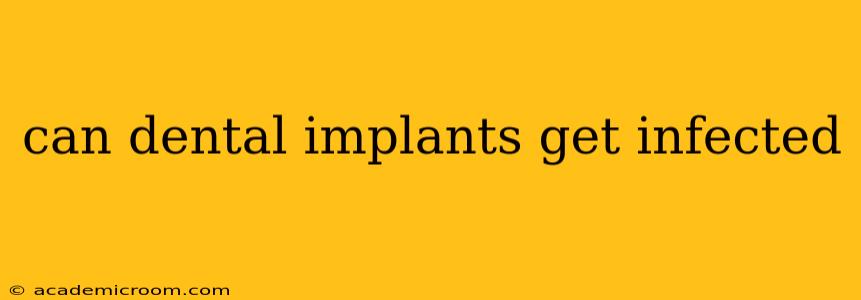Dental implants, while remarkably successful in restoring smiles and oral function, aren't immune to infection. Understanding the risks, symptoms, and prevention strategies is crucial for maintaining long-term implant health. This comprehensive guide will address common concerns surrounding implant infections and provide valuable insights for patients and dental professionals alike.
What is Peri-Implantitis?
The most significant infection risk associated with dental implants is peri-implantitis. This is a serious inflammatory condition affecting the tissues surrounding the implant. Unlike gingivitis (gum inflammation around natural teeth), peri-implantitis involves the breakdown of the bone supporting the implant, potentially leading to implant failure if left untreated. The infection can spread, causing significant pain and discomfort.
What Causes Peri-Implantitis?
Peri-implantitis is primarily caused by bacterial plaque accumulation around the implant. Poor oral hygiene is a major culprit, allowing bacteria to thrive and inflame the surrounding tissues. Other factors contributing to the development of peri-implantitis include:
- Smoking: Nicotine significantly impairs healing and increases susceptibility to infection.
- Diabetes: Poorly controlled blood sugar levels weaken the body's immune response, making it harder to fight off infections.
- Compromised immune system: Individuals with weakened immune systems are at higher risk of developing various infections, including peri-implantitis.
- Bruxism (teeth grinding): Excessive force on the implant can damage surrounding tissues and increase the risk of infection.
- Inadequate implant placement: Improperly placed implants are more prone to infection.
What are the Symptoms of a Dental Implant Infection?
Recognizing the symptoms of peri-implantitis early is vital for successful treatment. Common signs include:
- Swelling and redness around the implant: This is often the first visible sign of infection.
- Bleeding gums: Bleeding during brushing or flossing around the implant is a cause for concern.
- Pain and discomfort: Persistent pain or tenderness in the area around the implant.
- Pus discharge: The presence of pus is a clear indication of infection.
- Loose implant: A noticeably loose implant indicates significant bone loss.
- Bad breath (halitosis): Persistent bad breath, especially emanating from the implant area.
How are Dental Implant Infections Treated?
Treatment for peri-implantitis depends on the severity of the infection and the extent of bone loss. Mild cases may be treated with:
- Improved oral hygiene: Meticulous cleaning with specialized brushes and interdental cleaning aids.
- Professional cleaning: Regular professional cleanings to remove plaque and calculus.
- Antibiotics: To combat the bacterial infection.
More severe cases may require:
- Surgical debridement: A surgical procedure to remove infected tissue and plaque from around the implant.
- Guided bone regeneration: A procedure to stimulate bone growth around the implant.
- Implant removal: In cases of extensive bone loss or persistent infection, implant removal may be necessary.
How Can I Prevent a Dental Implant Infection?
Prevention is always better than cure. By diligently following these preventative measures, you can significantly reduce your risk of developing peri-implantitis:
- Maintain excellent oral hygiene: Brush and floss thoroughly twice a day.
- Regular professional cleanings: Schedule regular checkups and professional cleanings with your dentist.
- Quit smoking: Smoking significantly increases the risk of infection.
- Control diabetes: Maintain optimal blood sugar levels to support immune function.
- Avoid clenching or grinding your teeth (bruxism): Consider using a mouthguard if necessary.
- Choose an experienced implantologist: Ensure the implant is placed by a qualified and experienced professional.
Are there different types of dental implant infections?
While peri-implantitis is the most common and severe type of dental implant infection, other infections can occur, such as infections during the initial implant placement surgery (osteointegration) or infections of the soft tissues around the implant (peri-mucositis). Peri-mucositis is a less severe infection that only impacts the soft tissues, but if left untreated, it can progress to peri-implantitis.
How long does it take for a dental implant infection to heal?
The healing time for a dental implant infection varies depending on the severity of the infection and the treatment required. Minor infections may heal within a few weeks with diligent oral hygiene and professional cleaning. However, more severe cases involving surgical procedures might take several months to fully heal.
Can you get a dental implant infection years after placement?
Yes, a dental implant infection can occur years after the implant placement. While the risk is higher in the early years after placement, poor oral hygiene or other contributing factors can lead to infection even after several years. Regular dental checkups and proactive oral care remain essential throughout the life of the implant.
This guide provides general information. Always consult with your dentist or periodontist for personalized advice and treatment regarding dental implant infections. Early detection and appropriate treatment are critical for maintaining the success and longevity of your dental implants.
